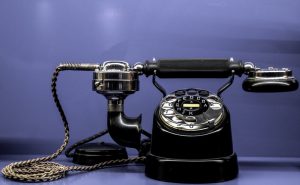
Every time a client calls your business, they’re judging you. Seriously, the outcome of a business phone call is much more than whether or not you were able to resolve a client’s problem, or answer their question. That’s why every single time your office phone rings, you should be prepared for a mini interview. Our phone manners have slipped drastically thanks to the fact that we usually don’t have to talk to people anymore. Unfortunately for those who rely on a string of emojis 🙄💁👌🖐🌮🍩🚲💕 for personal communication, a professional setting requires real eloquence, accuracy, and plain old good manners on the phone. As a phone company, we like to think we know a thing or two about how to conduct a business call, so we’ve compiled our best advice to make sure that mini interview results in rave reviews of your service and your brand in general.

Especially if a phone call is one you’re aware of in advance, prep for it. Anticipate the conversation topics and inquiries that are most likely to arise, and jot down bullet points to keep your discussion and answers focused and correct. Don’t be caught off guard if you can help it—have a standard friendly greeting for clients and you’ll be much more likely to avoid awkward pauses or insertions of “uhs” and “uhms” when answering.
Answer the phone in 2-3 rings whenever possible. Picking up on ring #1 takes a caller by surprise, and 4 or more rings tend to make a caller impatient. And never miss important calls—use a mobile app to take your work line calls on the go—from luncheons, to meetings, to all-day conferences.

Growing up, my sister and I had a tendency to be just a bit on the sassy side, and our mother’s response (as she sent us to a time out, of course) was always that “It’s not what you say, it’s how you say it.” This rings (no pun intended) truer than ever when it comes to taking client calls—someone is far more likely to remember how kindly (or not kindly) you treated them than how efficient you were at solving their problem.
This said, always be clear with your client about what’s going on—simply communicate. Always ask before putting a client on hold, never leave them there more than a minute, and always take them off hold with an apology for the wait. A phone with a park feature will allow you to put a call on hold for anyone in the office to pick up for easy connecting. If a long lapse is absolutely unavoidable, offer to call them back (and do so) as soon as you can solve their issue or respond to their inquiry. Even better would be to use a system with a queue callback feature so they can request to be called back immediately, without ever having to waste time waiting.

Make an introduction when you answer the phone, ensuring you get your client’s name so you can address them using it moving forward. Not so good with remembering names? Jot it down immediately for when you forget it later. You should also use an introduction when “connecting your client” to someone else. When you “transfer” someone, it implies that you’re just handing them off. Instead, connect them with someone more knowledgeable about a given problem, and make the introduction yourself.

Sometimes, it’s okay to stick to basics. There’s no reason to be overly formal on the phone, but old school manners stand out from the lack of etiquette that’s become more common. Check out Mental Floss’ quirky, traditional phone tips for added advice.
Make sure the call is really over before it’s over. Ask your client if they need your assistance with anything else, and let them know they’re always welcome to give you a call with further questions. Then, as a rule of thumb, let them hang up first.
Lost calls, dropped calls, and unreturned calls are just bad manners. Swear off poor phone etiquette with a system that transcribes your voicemail to email, and ensures you receive every single call with HD voice quality no matter where you are. To make a change for the better, drop us a line!
Happy calling,
Katie
TeleVoIPs

© 2024 TeleVoIPs, LLC
All Rights Reserved